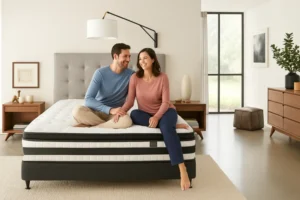What makes a house a home? How do you spread tidings of comfort and joy around your apartment? Will roasting chestnuts on an open fire really make you feel like your troubles are miles away?
We know, instinctually, that the way our homes look can affect how we feel — but it’s less clear how to produce the specific feelings we want. That’s the question Google and Johns Hopkins University researchers were trying to answer in 2019 when they set up an interactive art installation-slash-experiment at a high-end furniture trade fair in Milan, Italy. Scientists gave visitors wristbands that could monitor several different biomarkers, such as heart rate, and then guided them through a series of model living and dining rooms set up with similar furniture but different themes. Those themes were created by altering color selections, lighting, smells and fabric textures. Then the scientists asked participants which rooms made them feel the most sense of calm and ease.
And then something strange happened …
“Sometimes what people thought cognitively that they liked the best or where they thought they were most at ease [was] not what their biometric data said,” explained Tasha Golden, director of research for the International Arts + Mind Lab at Johns Hopkins School of Medicine. “There was a distinction between what people thought they liked the most and what their bodies seemed to respond to.”
At a time of the year when our thoughts naturally turn to hominess and coziness, it would be nice if science could tell us exactly how to create that hygge we’ve all heard so much about. Researchers are certainly trying, but in the process of quantifying comfort, they have also discovered that the objective study of subjective concepts can produce some really weird results. The good news is that disconnects like the one Johns Hopkins researchers discovered don’t mean the study of how and why we perceive aesthetics is pointless. Even if nobody can pin down what “hominess for the holidays” should look like, exploring our individual and cultural tastes can still help scientists better understand the brain, help you achieve better health outcomes, and maybe even help you avoid an expensive remodel on your house.
Turns out, it’s not uncommon for researchers to uncover differences between what people say they like and what their body actually responds to positively. Lindsay Graham, a research specialist at the Center for the Built Environment at UC Berkeley, said she has run across similar issues in her attempts to understand what kinds of architectural environments relax people. She attributed the disconnect to the simple fact that our aesthetic judgments don’t happen in a cultural vacuum.
“We see things in Instagram ads that are aesthetically pleasing, and maybe they do align with some part of ourselves or what we want,” Graham said. “But if it doesn’t actually fit who we are or what we need, then it’s not really going to accomplish what it is that we think it is.” In other words, there’s a difference between what you think you should like and what actually makes you feel at home.
And that’s not the only subjectivity stumbling block that researchers run into when studying coziness. Anjan Chatterjee is a professor of neurology at the University of Pennsylvania School of Medicine. What makes us feel comfortable and at home changes depending on where we are, he told me. People in his studies rate indoor spaces as being homier if they have elements from outside — plants, for instance, or natural materials and patterns. But outdoor environments rate as more homey if they have elements of order to them, like a tidy English garden.
Culture also seems to affect aesthetic judgments. So far, the scientists we spoke to said, most of the research into the science of aesthetic perception has been focused on subjects from the United States and European countries. But when it’s been conducted in other regions and nations, differences quickly arise. “We have a really large database of survey perceptions that look at what predicts satisfaction” with an architectural space, Graham said. “In our primarily North American population, we saw that it’s amount of space that matters. But in a recent study, we had found that it was cleanliness in Singaporean spaces that was most predictive of being satisfied.”
This kind of variability should make researchers wary of ascribing too much certainty to what they think they know about how humans make aesthetic judgments, said Bevil Conway, a senior investigator at the National Institutes of Health who studies the way our brains perceive color. It’s really easy to hook someone up to an fMRI machine or give them a bunch of surveys and assume you’re learning something universal about beauty — when what you’re really doing is testing how well people conform to preconceived ideas of what looks and feels nice.
But that also doesn’t mean it’s impossible to know anything about aesthetics. Scientists might not be able to tell you exactly how to decorate your house so that you and everyone who visits will feel cozy, but Golden said there’s evidence that a wide swath of humans find the sound of running water, and other natural noises, to be calming and peaceful.
That’s not necessarily a universal effect, but it’s pretty close, she told me — enough that you could think of it as being true for humans, generally, even if it isn’t true for every individual. Her team at Johns Hopkins is interested in this kind of research because they believe it can point towards techniques that improve health and wellness. For instance, those nature sounds might have a stress-relieving effect on some people. More important than hints like these are larger questions that Golden’s work is trying to answer about how the things we like impact our physiology. Even if the specific likes are distinct between individuals, the effects might be more universal. “When somebody just says, ‘I am cozy,’ what does that do for their well-being? Or how might the absence of that be affecting their health and well-being?” she said.
Those questions tie in with Chatterjee’s work, which has found that when people see a space that they describe as being beautiful, the experience triggers in the parts of the brain that scientists associate with our body’s internal reward systems — the same as what happens when we get pleasurable food or good sex.
Graham also thought there might be similarities between how people want spaces to make them feel, even if they have different ideas of what makes that space cozy. Her team has worked on studies that tried to figure out what emotional expectations people have for different rooms of the house. Their samples were from North America, but they found a lot of consistency here, she said, with respondents generally wanting one of two things from a bedroom: Restful comfort or romantic intimacy. This might seem obvious, she told me, but from an architect’s point of view, it can be beneficial to understand how clients want their rooms to feel — because that framework can guide discussions and ensure that clients are happier, for longer, in the spaces that have been designed for them.
Beyond the practical, though, there’s reason to be interested in the science of subjective aesthetics just because it’s really, really weird. “I can ask you, ‘Hey, Maggie, what’s the color of a banana?’ and you’re not even looking at one and you could visualize what it looks like,” Conway said. “So we know that the brain is doing this really interesting thing [with color], which is somehow integrating across time. It’s allowing you to sometimes predict the future and to remember the past.” His work has involved mapping the parts of the brain that help process color in both human and non-human primates and he’s found color processing circuits in places he didn’t expect, including parts of the frontal cortex usually associated with decision making.
The color of a banana may seem pretty removed from the comfort of your parent’s living room at Christmas, but both are aesthetic experiences that are as influenced by human culture as they are by science. From the perspective of physics, the yellow light of a candle is physically colder than the bluish light of a fluorescent bulb — but we call the yellow light warm, because we often associate it with the cozy feelings of a house in winter.
For people like Conway, understanding how our brains tie all these associations together, how those meanings can shift, and how a change in our society can affect how we think about a color … or a place … well, that’s just cool.

:max_bytes(150000):strip_icc()/Health-GettyImages-2187328842-0ff87870ab884e108a5b113dc29a37ef.jpg)



